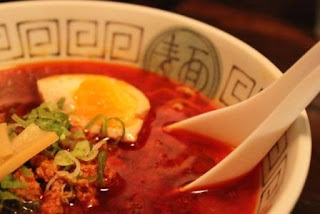| Tonkotsu Ramen from Umaido *See more of what I eat at my tumblr: KikiandRhubarb. All photos and content are copyrighted and may not be used without permission |
Fancy ramen. An interesting concept which in college, meant i added spinach or bok choy, some hot dogs or spam and an egg to my package ramen. Today, fancy ramen is still what i've just described, but it can also be a mouth-watering rich and flavorful bowl of miso pork broth and hand pulled noodles with thick cuts of char siu and a perfectly soft-boiled egg. I'm drooling as I sit here in this Caribou just thinking about it. Don't judge me. I mean, who knew that the many years of my childhood thinking ramen only came in plastic packages were so wrong.
Ramen has always been a menu item on most Japanese restaurants including RuSans, believe it or not; but, only in the last 4-5 years has it really blossomed in Atlanta. And I say "blossomed" in the most conservative way. It's still easily found on the menus of almost all of Atlanta's Japanese staples: Haru Ichiban, Nakato, Taka, Yakitori Jinbei, Sushi Yoko, Sushi Huku or it's offpsring Bishoku. None of which can really steer you wrong, but there are also the newer crop of ramen houses like the Korean owned Umaido or Raku, or the izakayas: Shoya Izakaya (pictured below) and most recently, Miso Izakaya.
 |
| Tan Tan Ramen at Shoya Izakaya |
Rumored to be of Chinese origin, this delectable noodle soup somehow found its way to Japan and over the years evolved and grew in popularity to become the iconic dish it is today. I'll let you wiki the various theories on how exactly it came to Japan or how it became so popular, but here's what you need to understand: ramen is revered in the way we southerners love our pulled pork and barbecue. Some even consider it an art. They love it so much there's even a ramen museum in Yokohama. Though none of this should be surprising given the culture and what we know of their perspective on the art of sushi. [Side note, if you haven't seen the documentary, "Jiro dreams of sushi" then you need to immediately add it to your Netflix queue. It'll give you a whole new appreciation.]
 |
| Tonkotsu Ramen at Shoya Izakaya |
Phở,
Let's briefly talk about the basics. Ramen is generally made from a chicken or pork stock combined with a variety of ingredients from onions, shiitake mushrooms, niboshi (dried baby sardines) kombu (kelp) or Katsuobushi (skipjack tuna flakes) and flavored with salt, miso or soy sauce. It is found in all regions of Japan today with hundreds of variations including curry or even cheese, but there are really only four different styles of broth flavors you'll see here in the U.S.
TONKOTSU My personal favorite, tonkotsu ramen has a cloudy thick broth from boiling pork bones, fat and collagen - in many cases for more than 12 hours to give it that true rich, hearty pork flavor and creamy consistency. It's served with toppings like pickled ginger, char siu, bean sprouts, green onions and of course a soft boiled egg. It's a specialty of Kyushu and Fukuoka.
SHOYU Soy sauce-based and tends to have a salty almost tangy taste to it, Shoyu is lighter than tonkotsu style broth. Often served with marinated bamboo shoots, green onions, fish cakes, bean sprouts, noti and of course a soft boiled egg. Some say this is the most common style. Its' a specialty of Tokyo.
MISO Uniquely Japanese, they say...Miso ramen has a robust, tangy flavor and combines miso (yes like the paste) with chicken or fish broth to create a nutty, slightly sweet but still hearty soup. Its toppings include butter and corn, leeks or onions, ground pork, cabbage, or even a spicy bean paste known as tobanjan.
SHIO The oldest and the lightest ramen style, Shio broth is flavored with salt and any variety of chicken, vegetables, dried seafood and seaweed. A specialty of Hakodate.
| Tonkotsu Ramen (previously) offered only at lunch at Miso Izakaya |
Ramen is as much comfort food to me as a home-cooked bowl of phở by my mother or a thick juicy cheeseburger with house made pickles from Bocado. (Another post for another time). To me, good ramen -- from the first sip, warms my soul and brings an unmistakable deep and satisfied "mmmmm." Sometimes I feel great food can be (is quite often) better than sex. But I digress...
| Not gonna lie, I wish he'd slice that pork belly, but check out that beautiful soft boiled egg. |
At the end of the day, everyone's palate is different. So the next time you're out for Japanese or in the neighborhood of one of the aforementioned ramen spots, stop in. Take a chance and experience the phenomenon that's gripped so many in our fair city. Grab your chopsticks and brave the broth. If your first sip makes you go "mmmmmm," then by all means -- slurp your way to the bottom of that bowl.
Last, I leave you with this video on how to "orkin-ize" your Ramen. From Ivan Orkin himself -- the culinary genius behind IvanRamen and IvanRamen plus in Tokyo and coming soon to NYC.
Happy eating!
**All photos in today's post were taken by yours truly and not to be used without permission.
No comments:
Post a Comment